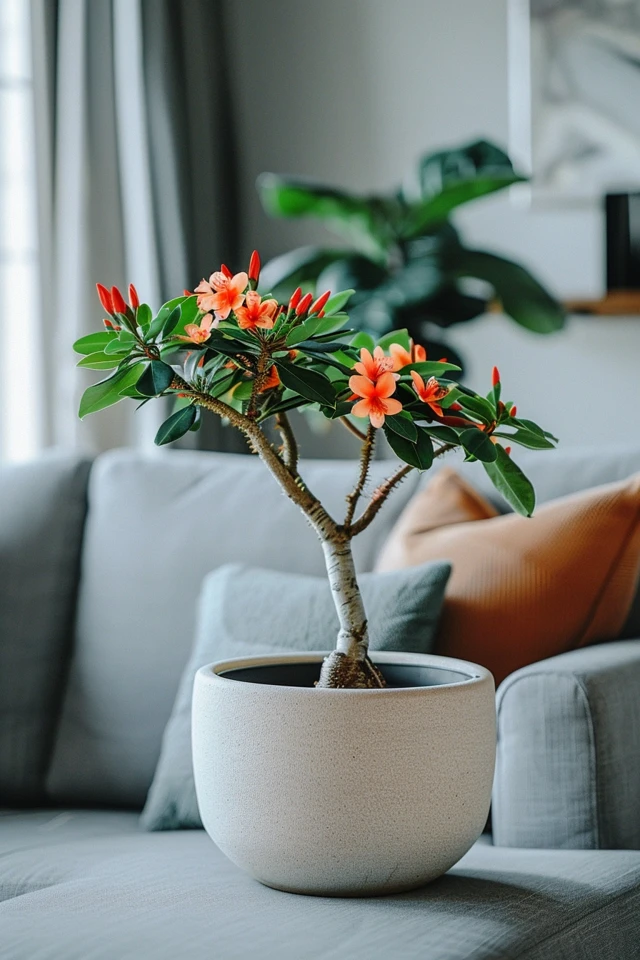Repotting a desert rose plant is a crucial step in encouraging healthy growth and stunning blooms. Knowing when and how to repot your desert rose can make a significant difference in its overall health and flowering potential.
The general rule of thumb is to repot during the plant’s period of active growth, which is typically in the spring. When repotting, it’s important to choose a container with good drainage and use a well-draining potting mix formulated for cacti or succulents. Additionally, be sure to handle the plant with care, as its sap is toxic.
By following these repotting tips and providing the right conditions, you can successfully encourage your desert rose to thrive and produce beautiful blooms.
Key Takeaways:
- Repot your desert rose during its active growth period, typically in the spring.
- Choose a container with good drainage and use a well-draining potting mix designed for cacti or succulents.
- Handle the plant with care, as its sap is toxic.
- Provide the right conditions to encourage your desert rose to thrive and produce beautiful blooms.
- Monitor the signs of overcrowding or root rot to determine when it’s time to repot your desert rose.
Signs That Indicate the Need for Repotting
Knowing when to repot your desert rose is essential for its continued growth and health. By observing these signs, you can determine when it’s time to give your desert rose a new home.
Pot Size and Root Emergence
One clear sign that your desert rose needs repotting is when the roots start to emerge through the drainage holes of its current pot. This means that the plant has outgrown its container and needs more space to continue growing. Repotting into a larger pot will provide the necessary room for the roots to expand, allowing the plant to thrive.
Stunted Growth
If you notice that your desert rose seems to be stuck in a growth rut and isn’t growing as vigorously as before, it may be a sign of overcrowding. When the roots become cramped and have no room to spread out, the plant’s growth can become stunted. Repotting into a larger container will give the roots the space they need to develop, promoting healthier and more robust growth in the future.
Yellowing Leaves and Root Rot
Yellowing leaves can be an indication of root rot, which can occur when the plant is kept in a pot that lacks proper drainage. Excess moisture can lead to root rot, causing the roots to decay and negatively impacting the overall health of the desert rose. If you notice yellowing leaves and suspect root rot, repotting into a well-draining potting mix and ensuring proper drainage can help prevent further damage and improve the plant’s overall condition.
Sometimes, repotting your desert rose is necessary to provide it with the space and resources it needs to thrive. By paying attention to signs like root emergence, stunted growth, and yellowing leaves, you can ensure that your desert rose stays healthy and vibrant.

Soil Selection and Preparation for Repotting
When repotting a desert rose, the choice of soil and proper preparation are crucial for the plant’s success. To create the ideal growing environment, it’s important to select a well-draining soil mix that closely resembles the desert habitat of the desert rose. This will help prevent waterlogged roots and promote healthy growth.
A recommended soil mix for desert roses consists of a combination of materials that provide both drainage and moisture retention. You can use a blend of sharp draining materials such as perlite, coconut coir, or peat moss to help retain moisture while ensuring excess water drains away. Adding coarse sand to the mix further enhances drainage, preventing water from pooling around the roots.
In addition to drainage, it’s essential to consider the pH of the soil. Desert roses prefer slightly acidic soil, with a pH around 6.0. Maintaining the right pH level is crucial for the plant’s nutrient uptake and overall health.
Before repotting your desert rose, make sure to thoroughly soak the potting mix and allow it to drain any excess water. This step ensures that the soil is at the optimal moisture level and ready for repotting. By using a well-draining soil mix, preparing it appropriately, and considering the pH, you can create an ideal environment for your desert rose during the repotting process.


